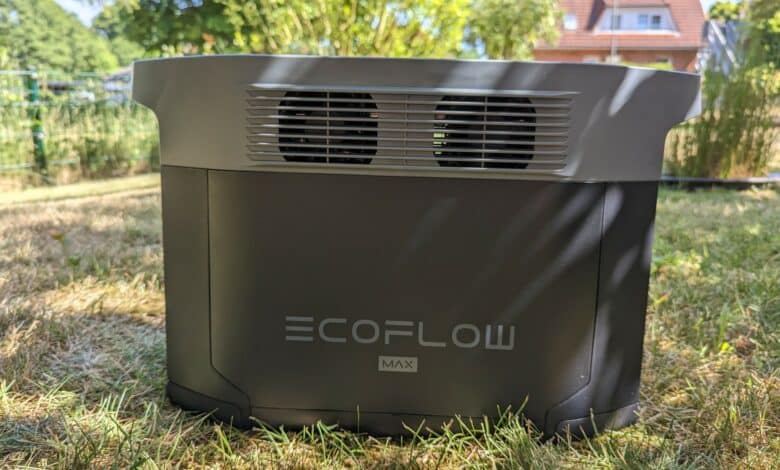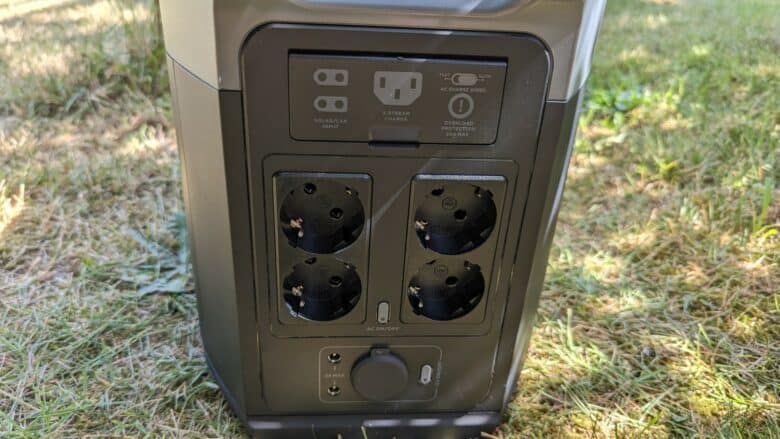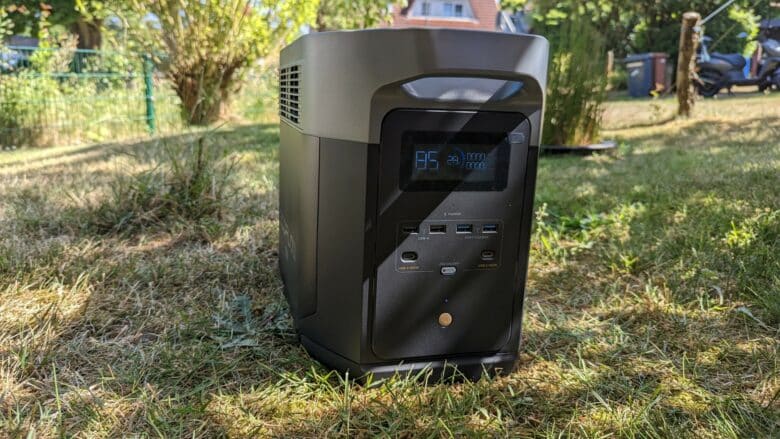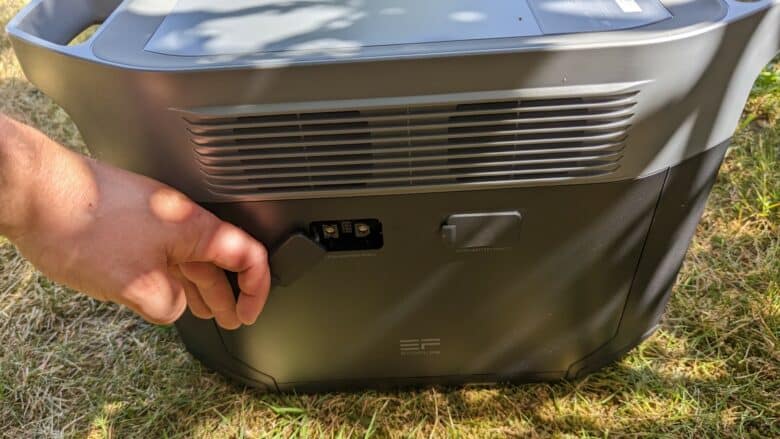
Power stations have become much more popular in recent years. This can be attributed to a wide variety of developments: rising electricity prices, increased interest in renewable energies or efforts to achieve self-sufficiency. Against this background, it is hardly surprising that more and more new and more powerful power stations are being launched on the market. EcoFlow is actively involved in this development and recently presented the Delta 2 Max power station. The latest model is advertised as a portable power station, can also be charged by solar panel and is compatible with the balcony power station EcoFlow PowerStream, thus enabling a self-sufficient power supply. We also find interesting the fact that the power station is equipped with lithium iron phosphate batteries.
EcoFlow has kindly provided us with the Delta 2 Max for the purpose of testing. We have put the power station under the microscope extensively over the past few weeks and used it in a wide variety of everyday situations. How it performed in our test, we reveal in the following lines.
| Performance | 2,400 watts (3,100 with X-Boost) |
| Battery capacity | 2,048 Wh |
| Battery technology | LiFePO4 |
| Lifetime | 3,000 charging cycles |
| Outputs |
|
| Inputs | AC, solar and car charging port |
| Charging time |
|
| Uninterruptible Power Supply (UPS) | no |
| App | yes |
| Price | € 2,089.00 * |
Design and finish
Our first impression of the Delta 2 Max is positive. Unlike many competing products, it doesn’t feature gaudy colors or come up with other visual bells and whistles. Instead, it presents itself as rock-solid and restrained. This has the advantage that it can easily fit into the most diverse environments. Practically, the power station is also designed for transport: Two comfortable handles are found on the sides. However, the first major surprise of our test came when we lifted the box: It is surprisingly heavy. It actually weighs 23 kilograms and can thus hardly be transported with bare hands during a camping trip. Only shorter distances are feasible this way.
The weight is also surprising considering the dimensions of 50 x 24 x 31 cm, which make the Delta 2 Max look quite handy. However, it is not excessively heavy compared to competing products. Thus, it is a circumstance that should generally be taken into account when buying a power station.
The box rests on large rubber feet, which ensure a secure stand. However, it won’t be able to be used completely reassured, at least outdoors. For example, there are ventilation slots on the top of the box, which ensure that the power station is not waterproof. Added to that is the fact that there are no covers for the USB and power ports. Thus, the penetration of liquid and/or dust has to be feared here as well. If you want to use the power station for camping, for example, you have to make sure to find a well-protected location. On the other hand, the case is fireproof; it is certified according to UL94-5VA.

The power station can score points again with the port variety, which we will look at in more detail in the next section, as well as with a charging display on the front. The display looks a bit old-fashioned, which gives the Powerstation a special charm.

In addition to the Delta 2 Max, the package includes a 12 V cable, a power cable for charging at the wall socket, and a cigarette lighter cable for charging in the car. However, a cable for connecting to a solar panel is missing.
Connection options and compatibility
As mentioned earlier, the connectivity of the Delta 2 Max is a major advantage. It is equipped with six USB ports, four of which are USB-A and two of which are USB-C with power delivery for devices of up to 100 watts, with four 230 V sockets, a 12 V automotive socket with ten amps and two 12 V round sockets with three amps. This ensures that numerous different devices can be connected in a wide variety of locations. EcoFlow thus also makes it clear that the Delta 2 Max is definitely intended for a self-sufficient power supply. Two of the USB-A sockets and two of the 230 V sockets provide an output power of 12 and 18 watts respectively.

What surprised us a bit is the fact that the ports are distributed over the entire device. The USB ports are found at the front, the 230 V sockets at the top of the rear and the rest of the ports at the bottom of the rear. In addition, there are two small flaps on the right edge of the back, behind which there are inputs for additional batteries, with which the capacity of the power station can be tripled to up to 6 kWh. The PowerStream inverter is also connected via this.

Overall, however, the port variety is clearly positive. Many different ports ensure that the power station can be used flexibly.

Battery
EcoFlow’s Delta 2 Max is equipped with lithium iron phosphate (LiFePO4) batteries. This is a significant difference from the previous model, which should make the new power station particularly durable. Lithium iron phosphate batteries are known for lasting a long time and not losing their performance as quickly as lithium ion batteries. In this context, EcoFlow promises that a battery capacity of 80 percent is still achieved after 3,000 charging cycles. The capacity is 2,048 Wh. We could not verify this promise in our practical test for obvious reasons – after all, that would correspond to a service life of around ten years. In comparison: Lithium-ion batteries lose 20 percent of their performance after about 200 charging cycles. We generally consider the use of lithium iron phosphate batteries to be very positive: It is both economically and ecologically sustainable.
In our test, charging the batteries worked flawlessly and, above all, quickly. A charge of around 80 percent was achieved after just one hour. The power station was fully charged after just over one and a half hours. It should be noted that we charged the Delta 2 Max via the power supply. If it is charged via a solar panel, it should take longer since a lower maximum charging power is then available. Furthermore, the charging speed when charging via solar panel also depends on the weather. EcoFlow promises the best results with combined charging with solar and AC power: Then it should only take 43 minutes to charge the box to 80 percent. In practice, a bit more time is likely to be needed depending on how the sun shines. The specification for pure AC was also slightly exceeded in our practical test with a charging time of around one hour.
It was loud during charging in our test. We measured a volume of slightly less than 42 dB at a distance of about half a meter. The volume is noticeably and measurably reduced when the charging power is reduced – but so is the charging speed. With a noise level of 42 dB, EcoFlow’s power station is within an average range: Competitor products are about similarly loud, in many cases minimally louder.
Performance
It is obvious that the Delta 2 Max is powerful with its capacity of 2 kWh. In our practical test, we connected all sorts of devices to it and saw when it reached its limits. That should not be the case in everyday use anytime soon. Smartphones can be recharged hundreds of times, and even a gaming PC can be operated for hours with the power station. Refrigerators and even dishwashers can also be supplied with power via the Delta 2 Max without any problems. It should be noted, however, that the time for which the power station can provide power decreases with the number and energy requirements of the connected devices. The Delta 2 Max’s output power is 2,400 watts and can be permanently increased to 3,100 watts via the X-Boost function.
For a self-sufficient supply, the box has to be equipped with additional batteries; otherwise, it won’t be able to lift an entire household. However, those who want to use it to save a bit of electricity costs and outsource some devices to it should not run into limits. Noise-wise, this is also not to be expected. At an output power of just over 100 watts, the internal fans turned on in our test. The noise level is then comparable to that of a desktop PC. The power station remains silent at an output of less than 100 watts.
Overall, we are very satisfied with the performance. We also rate the app that EcoFlow provides as positive. Detailed information about the box’s current state can be accessed via it. In addition, there is the option to make settings here.
Conclusion
Overall, we rate the Delta 2 Max from EcoFlow positively. The compact power station was able to convince us with its performance and its lithium iron phosphate battery. In the practical test, the battery could be charged quickly and subsequently supplied numerous common household products with power reliably – and at a low volume. Short charging times, compatibility with solar panels or balcony power plants and the resulting possibility of a self-sufficient power supply round off the power station with its many connection options.
We only noticed the largely missing protection of the connections negatively, which ensures that the power station should only be operated outdoors with caution and in selected places. We rated the weight of 23 kilograms as neutral, which makes a transport aid necessary for longer distances.
In terms of price-performance ratio, the Delta 2 Max is only in the midfield: With a price of 2,099 Euros, it is comparatively expensive. The additional batteries are also not exactly affordable with a price of 1,499 euros each.
EcoFlow Delta 2 Max
Design & workmanship
Battery
Performance
Value for money
92/100
A strong power station with lithium iron phosphate batteries. Quiet in operation, durable and without major weaknesses.











